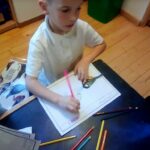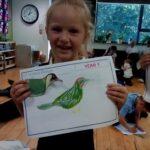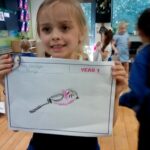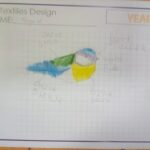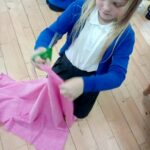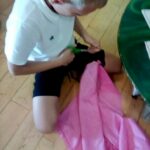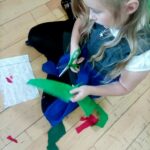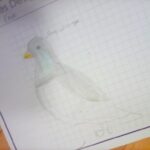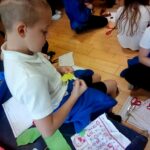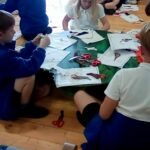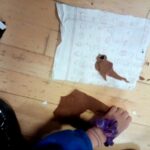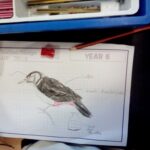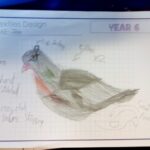Over this two-week session (partnered with a science data check) the children have been investigating fabric and textiles. In their first session they looked at how fabric is made and how it can be designed for very specific uses, like being waterproof, made for strength or made to be luxurious.
In our discussions the children were amazed to discover how much fabric is around us and the different uses it has. Alongside this we looked at the impact through away fabric can have on the environment and how, as designers, they could look to recycle and reuse fabrics.
Years 1 and 2:
Evaluation and Design-
Design a functional and appealing product for a chosen user and purpose based on simple design criteria.
To start our session, we asked the question: ‘What is fabric?’
To help with their understanding we taught them how fabric is made and what it is used for.
Children to carry out their investigation: What different types of fabric are the toys made out of?
Children investigated different fabric toys and identified the different types of fabric they were made out of. Our investigations helped them to come up with their own design criteria. They then looked at how they could use this in their own designs.
Retrieval Questions and key vocab:
What are the four different seasons?
What would you expect to see change on your tree in autumn?
What clues help me to find an oak tree, a hazel tree and a holly tree?
Year 3 and 4:
Evaluation and Design–
Understand how a key event/individual has influenced the development of the chosen product and/or fabric.
To start our session, we asked the question: ‘What is fabric used for in people’s homes?’
Then go through the KS2 power point and ensure that they know how fabric is used for both quality of product and that techniques can be used for decoration and aesthetic appeal
Part 2
Children to carry out their investigation:
Are your shoes winter proof?
As a class go through the different parts of a shoe and what they are used for / how they are different
The children are to do this in their mixed ability groups. Support those children who may need help to write down thoughts and ideas.
Children to use own shoe and investigate the four parts
Make notes on the fabric’s quality and attributes
Decide whether their show is winter ready.
We took a photo and of our selves in either Mushroom or Bluebell Woods. We will continue to take photos of that area, in each season, and noticing the changes in both plants and the animals living there. We also have been using the ID sheets to collect data. We went though the sheet together and looked at what animals we had spotted and which ones we hadn’t. If we didn’t see an animal we didn’t mark it off on our data – this is as important so we know what animals are missing in autumn.
Retrieval Questions and key vocab:
What birds did you see outside?
Where would you find minibeasts (invertebrate) in the outside classroom?
When looking at the different types of trees, what clues could you look for?
Years 5 and 6:
Evaluation and Design–
Develop, model and communicate ideas through talking, drawing, templates, mock-ups and prototypes and, where appropriate, computer aided design.
To start our session, we asked the question: ‘What fabrics are used for sports clothes?’
Ask them about the sports that they play and if they have to wear anything other than the PE kit that we have in school. Give them help with some of the names for different fabrics – Lycra, polyester, cotton, viscose etc.
Part 2
Children to carry out their investigation:
Which outer layer is best for each season and why?
As a class talk about the different processes through in order to change its use (waterproofing, Teflon coating etc.). Explain what outer wear is and get them to offer some ideas of the outer wear that they have in their own wardrobes.
The children are to do this in their mixed ability groups. Support those children who may need help to write down thoughts and ideas.
Children to use own shoe and investigate the four parts
Make notes on the fabric’s quality and attributes
Decide whether their show is winter ready.
We completed two investigations.
Tree Canopy – Animals Living Alongside Plants. Don’t worry, we’re not telling the children to vandalise trees, it was just a great way of finding out what interesting invertebrates (animals without backbones) live in the trees around the OC! It might sound a bit violent, but if done right, tree-shaking doesn’t harm the tree or the minibeasts that call it home. The children recorded what they found by issuing ID sheets and a tally chart.
Leaf Litter – Decomposers Helping Plants. Decomposers are an important part of our environment. We found them in the leaf litter on the forest floors. Decomposers take dead plant material and turn it into rich and nutritious soil to support new plants. We took a soil and leaf litter sample and recorded the decomposers that we found. Each term we will look at the forest floor and see when our decomposers are out and about.
Retrieval Questions and key vocab:
What is the science word we use for minibeasts?
Name three animals you found in the Tree Canopy investigations?
Will you expect to find more or less animals in winter and why?


